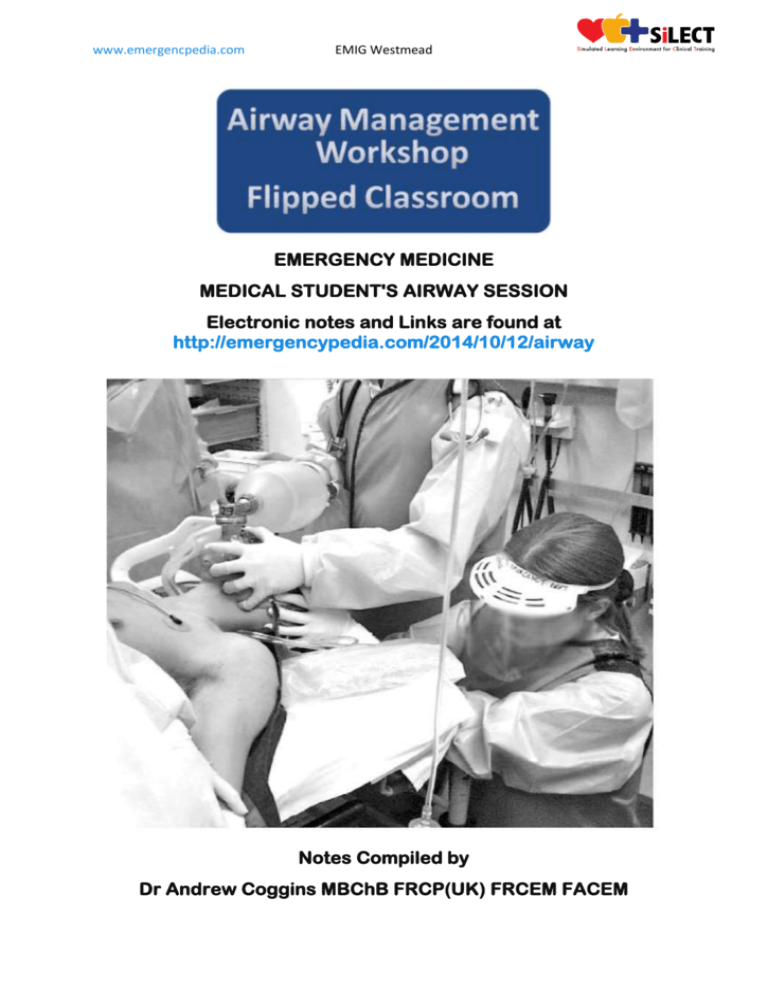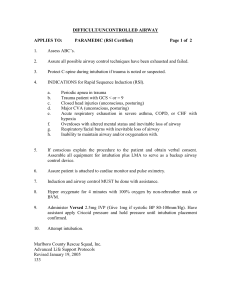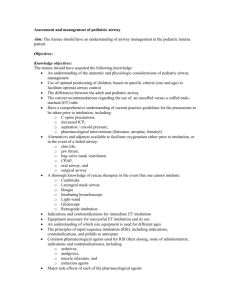airway workshop final
advertisement

www.emergencpedia.com EMIG Westmead EMERGENCY MEDICINE MEDICAL STUDENT'S AIRWAY SESSION Electronic notes and Links are found at http://emergencypedia.com/2014/10/12/airway Notes Compiled by Dr Andrew Coggins MBChB FRCP(UK) FRCEM FACEM www.emergencpedia.com EMIG Westmead OVERVIEW There are 4 major 'options' to effectively manage the Airway: 1. Basic Airway Manoeuvres with use of Bag Valve Mask (BVM) 2. A combination of option "1" with Adjuvant Devices such as oropharangeal and/or nasopharangeal devices Option 1 and 2 are the most important skills to practice diligently 3. An invasive Supraglottic Airway (Laryngeal Mask Airway) 4. Definitive Airway (either Endotracheal Intubation or access via the neck for an emergency subglottic airway) BASIC AIRWAY SKILLS Assessment of Airway and Breathing In order to assess airway and breathing: ‘DR-ABC’: Check for 1. Danger 2. Responsiveness of patient 3. Open the airway with basic manoeuvres A. jaw thrust B. head tilt chin lift 4. Remove obvious obstructions from the airway 5. Listen, Look and Feel for Breathing www.emergencpedia.com EMIG Westmead Ventilation Devices - BVM Key Points to Successful Ventilation: Remember to connect the device to an Oxygen Supply Use two providers wherever possible (see External Study) Maintaining a good seal is important for ventilating the patient. This is done in basic terms by lifting the face into the mask and applying a steady downward counter pressure to the mask. Try placing your little, ring and middle fingers of your left hand on the mandible in the shape of the letter ‘M’ and your thumb and fore finger on the mask in the shape of a ‘C’. Now ask a colleague to squeeze the bag to Ventilate. Don’t ‘bag’ too fast or hard - we recommend aiming for 10-12 breathes / min average rate of ventilation can be >40 per minute in cardiac arrests (see External Study) If ventilation remains difficult consider an Adjuvant Device (see below) Patients receiving BVM for cardiac arrest can do as well if not better than those who are intubated (see External Study) Failure to Ventilate a patient causes: associated with the mnemonic ‘M.O.A.N.S.’: Mask Seal (Size, hands, shape, beard, trauma) Obesity/Obstruction (Resistance, shape, faster desaturation) Age (Over 55 and pregnant women are harder) No Teeth (Face ‘falls’ inward) Stiff Lungs (Asthma, COPD etc) ADJUVANT DEVICES Commonly used adjuvant airway devices include the OROPHARYNGEAL and NASOPHARYGEAL airways: In the case of difficult ventilation in a patient who is not breathing or in the unconscious patient who is still breathing these devices may help you maintain the airway: Nasopharyngeal Airway Apply Lubricant and consider placing a pin through airway Place through nostril with a slight twisting motion straight back into nasopharynx Attempt to ventilate Patient with bag mask Avoid use in head injuries, facial injuries and with epistaxis www.emergencpedia.com EMIG Westmead Oropharyngeal Airway For adults size the airway from the tragus of the ear to the edge of mouth Insert upside down and rotate backwards over the tongue In children place the device in the ‘right way round’ to avoid trauma to the upper oropharynx SUPRAGLOTTIC DEVICES The Laryngeal Mask Airway (LMA) Dr Archie Brain developed the Laryngeal Mask Airway in the UK during the 1990s. Its widespread introduction has revolutionised Anaesthetics. These devices can be used for many day case type procedures and are also very useful in the Management of the Emergency Airway especially where attempts at Intubation have failed. They are increasingly recommended in the management of Cardiac Arrests. These airways are sometimes called ‘Supraglottic Devices’ For the Laryngeal Mask Airway the insertion technique is similar to placing an Oropharyngeal Airway. Slide device with steady pressure into the mouth towards the floor then round the back of the tongue with pressure towards your hips. You may feel a distinctive ‘pop’. There are various types including Classic LMA, ‘Supreme’, ‘Pro-seal', ‘I-Gel’ and the ‘Fasttrack’ (Intubating) LMA shown on the next page www.emergencpedia.com EMIG Westmead After successful insertion remember to inflate the device before attempting to ventilate (you often see and feel a ‘pop)’. Some advanced devices have a port for a Nasogastric tube. ENDOTRACHEAL INTUBATION A systematic assessment of the Airway is important prior to attempting intubation. A thorough pre-op assessment is a cornerstone of modern anaesthesia. In order to assess the ‘potential difficulty’ of intubation – we can use the ‘LEMON’ law: 1. 2. 3. 4. 5. Look Evaluate ‘332’ Malampatti Score Obstruction Neck Video - https://www.youtube.com/watch?v=TRKuCBOsp2o www.emergencpedia.com EMIG Westmead Endotracheal Intubation (Key Points) Prepare your Equipment in Advance of Procedure You will need appropriately sized endotracheal tubes, suction (working), equipment for ventilation (bag mask), pillow or head ring for head position, adjuvant equipment such as introducers and alternative blades to hand. Head position - Does the tragus of the ear line up with the sternal notch? Check the Laryngoscope is working (is the light on?) Hold handle in Left Hand (right hand is free to move the head and hold the tube) Place the Laryngoscope blade into the Right side of the mouth with help of an assistant if necessary Sweep the Tongue across to the left in order to push it out of the way... Insert the blade until you Visualise the Epiglottis Visualise the Epiglottis Lift the Laryngoscope Handle forward with steady force (do not ‘lever’ teeth) Look to Visualise the Vocal Cords www.emergencpedia.com EMIG Westmead Lift to reveal cords [wpvideo b5PuDOhJ] Optimise your view if necessary using "30 second drills" 30 Second Drills - Sydney HEMS to improve intubation success (troubleshooting) Place the tube or gum elastic 'boogie' through the cords (and ensure to visualise it going through). Be careful not to put ET tube in too far (if you do you may go past the carina and only ventilate the right lung) Connect the Bag and Valve Mask, Ventilate the Patient Gently and then Inflate the Cuff until any leaks disappear Connect the End Tidal CO2 (trace and tubing pictured below) www.emergencpedia.com EMIG Westmead Check the air entry on both sides in 3 positions to ensure equal air entry and then Secure the ET tube with tape or tie Document in the patient’s medical record [youtube=https://www.youtube.com/watch?v=BTh2JvVoy0I&w=640&h=385] Equipment Various equipment must be prepared prior to advanced airway management. The commonly used laryngoscope ‘blades’ include the MACINTOSH, MCCOY and MILLER types are shown on the next page www.emergencpedia.com EMIG Westmead Intubation Equipment Other Methods for Intubation Other complex techniques are used selectively by airway specialists (anaesthetists) for securing an airway. These may include ‘awake’ intubation by ‘blind nasal’ route or ‘fibreoptic’ method. This is often facilitated by the use of sedation and local anaesthesia. In addition recent developments in technology have increased the availability of devices such as the "C-mac" and "Glide Scope". This is likely to be widely available in the future and provides excellent views on an electronic viewing screen but is currently retailing at around 15000 dollars and is therefore not available in all Australian hospitals. www.emergencpedia.com EMIG Westmead Rapid Sequence Intubation (RSI) "Rapid sequence induction (RSI) is the standard procedure for prompt induction of anaesthesia and subsequent intubation used in the Emergency Department and ICU as well as in selected cases in the Operating Theatre." CLICK HERE for more information about RSI A CHECKLIST is recommended when carrying out this complex and challenging team based procedure EMERGENCY SURGICAL AIRWAY The Surgical Airway and Cricothyroidotomy Emergency physicians rarely do Surgical Airways and most doctors will never carry out this procedure. More commonly surgical airways are done by ENT surgeons for patients with a supraglottic obstruction (e.g. Laryngeal Tumours) and by ICU doctors for patients who required longer term ventilation (e.g. tracheostomy for intubated patients). A surgical airway may be indicated in a situation where the doctor can neither ventilate nor intubate the patient. This is now often referred to as "can't intubate can't oxygenate" (CICO) - this is a recognised anaesthesia emergency. Please note that this situation is rare but also important because failure to manage the problem immediately will lead to death or severe morbidity from hypoxic brain injury. There are two main ways to achieve access to the airway via the neck - either OPEN SURGICAL or NEEDLE / SELDINGER Surgical Method [youtube=https://www.youtube.com/watch?v=wVQFJR7qmrQI&w=640&h=385] Pros - Higher Success in NAP4 Study Cons - Bleeding, Our Fear www.emergencpedia.com EMIG Westmead Needle Method [youtube=https://www.youtube.com/watch?v=fNRDWN2OdpY&w=640&h=385] Pros - Most clinicians have familiarity with basic skills needed, Less Fear Cons - Failure in NAP4 Study, Temporising only Jet Insufflation Jet Insufflation can be used to oxygenate the patient where bag mask ventilation becomes impossible or inadequate. Jet Insufflation for oxygenation can be achieved simply by using a needle cricothyroidotomy (see video above) in order to achieve rescue oxygenation a simple cannula placed in the trachea is connected to the wall oxygen supply Assemble a simple circuit using: 1. 3 way tap for connection to cannula 2. 5 ml syringe with the bung removed attached to the 3 way tap 3. Simple oxygen tubing inserted into the back of the syringe 4. As an alternative you can use a pre-assembled circuit (some are specially designed for this purpose) The circuit needs to have a hole which when occluded allows controlled flow of gas into the patient. You can use a 3 way tap or cut a hole in the oxygen tubing. The thumb is used to occlude the hole intermittently typically with a ratio of 1:4 (higher ratios may be safer) “Specifically, 30 to 63 kg ruminants with an obstructed upper airway were resuscitated for 30 minutes from a hypoxic, hypercarbic, and acidotic state using 12- and 14-gauge catheters connected to a 50 psi oxygen source via a two-way valve with an I:E of 1:4 and 1:9 seconds, respectively. Shorter expiratory time or increased inspiratory time with these intravenous catheters resulted in significant hemodynamic compromise, barotrauma, inadequate carbon dioxide elimination, acidemia, and frequent death” This method is only used for a short period CO2 will accumulate due to no gases being able to come out of the lungs (in other words this method can oxygenate but not effectively ventilate the patient) The method may buy some extra time while a definitive airway can be established. It is especially useful in children because an open surgical procedure is very difficult in children under 10 due to size of the trachea







